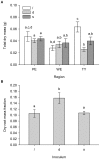Relative importance of biotic and abiotic soil components to plant growth and insect herbivore population dynamics
- PMID: 20886078
- PMCID: PMC2944872
- DOI: 10.1371/journal.pone.0012937
Relative importance of biotic and abiotic soil components to plant growth and insect herbivore population dynamics
Abstract
Background: Plants are affected by several aspects of the soil, which have the potential to exert cascading effects on the performance of herbivorous insects. The effects of biotic and abiotic soil characteristics have however mostly been investigated in isolation, leaving their relative importance largely unexplored. Such is the case for the dune grass Ammophila, whose decline under decreasing sand accretion is argued to be caused by either biotic or abiotic soil properties.
Methodology/principal findings: By manipulating dune soils from three different regions, we decoupled the contributions of region, the abiotic and biotic soil component to the variation in characteristics of Ammophila arenaria seedlings and Schizaphis rufula aphid populations. Root mass fraction and total dry biomass of plants were affected by soil biota, although the latter effect was not consistent across regions. None of the measured plant properties were significantly affected by the abiotic soil component. Aphid population characteristics all differed between regions, irrespective of whether soil biota were present or absent. Hence these effects were due to differences in abiotic soil properties between regions. Although several chemical properties of the soil mixtures were measured, none of these were consistent with results for plant or aphid traits.
Conclusions/significance: Plants were affected more strongly by soil biota than by abiotic soil properties, whereas the opposite was true for aphids. Our results thus demonstrate that the relative importance of the abiotic and biotic component of soils can differ for plants and their herbivores. The fact that not all effects of soil properties could be detected across regions moreover emphasizes the need for spatial replication in order to make sound conclusions about the generality of aboveground-belowground interactions.
Conflict of interest statement
Figures


Similar articles
-
Soil microorganisms control plant ectoparasitic nematodes in natural coastal foredunes.Oecologia. 2007 Jun;152(3):505-14. doi: 10.1007/s00442-007-0678-2. Epub 2007 Mar 8. Oecologia. 2007. PMID: 17345102 Free PMC article.
-
Soil legacy effects of plants and drought on aboveground insects in native and range-expanding plant communities.Ecol Lett. 2023 Jan;26(1):37-52. doi: 10.1111/ele.14129. Epub 2022 Nov 22. Ecol Lett. 2023. PMID: 36414536 Free PMC article.
-
Plant-mediated interactions between shoot-feeding aphids and root-feeding nematodes depend on nitrate fertilization.Oecologia. 2013 Dec;173(4):1367-77. doi: 10.1007/s00442-013-2712-x. Epub 2013 Jul 9. Oecologia. 2013. PMID: 23836091
-
Soil abiotic factors influence interactions between belowground herbivores and plant roots.J Exp Bot. 2013 Mar;64(5):1295-303. doi: 10.1093/jxb/ert007. J Exp Bot. 2013. PMID: 23505310 Review.
-
Mechanisms of plant-soil feedback: interactions among biotic and abiotic drivers.New Phytol. 2019 Apr;222(1):91-96. doi: 10.1111/nph.15603. Epub 2018 Dec 11. New Phytol. 2019. PMID: 30451287 Review.
Cited by
-
Life table construction for crapemyrtle bark scale (Acanthococcus lagerstroemiae): the effect of different plant nutrient conditions on insect performance.Sci Rep. 2022 Jul 6;12(1):11472. doi: 10.1038/s41598-022-15519-6. Sci Rep. 2022. PMID: 35794195 Free PMC article.
-
Agricultural land-use history does not reduce woodland understory herb establishment.Oecologia. 2019 Apr;189(4):1049-1060. doi: 10.1007/s00442-019-04348-6. Epub 2019 Mar 16. Oecologia. 2019. PMID: 30879140
-
Contrasting Responses of Multispatial Soil Fungal Communities of Thuja sutchuenensis Franch., an Extremely Endangered Conifer in Southwestern China.Microbiol Spectr. 2022 Aug 31;10(4):e0026022. doi: 10.1128/spectrum.00260-22. Epub 2022 Jun 23. Microbiol Spectr. 2022. PMID: 35735985 Free PMC article.
-
Contrasting Responses of Rhizosphere Fungi of Scutellaria tsinyunensis, an Endangered Plant in Southwestern China.Microbiol Spectr. 2022 Aug 31;10(4):e0022522. doi: 10.1128/spectrum.00225-22. Epub 2022 Jul 5. Microbiol Spectr. 2022. PMID: 35863021 Free PMC article.
-
Comparative impacts of aboveground and belowground enemies on an invasive thistle.Ecol Evol. 2017 Dec 27;8(3):1430-1440. doi: 10.1002/ece3.3751. eCollection 2018 Feb. Ecol Evol. 2017. PMID: 29435222 Free PMC article.
References
-
- Rowntree JK, McVennon A, Preziosi RF. Oecologia in press; 2010. Plant genotype mediates the effects of nutrients on aphids. - PubMed
-
- White TCR. Importance of a relative shortage of food in animal ecology. Oecologia. 1978;33:71–86. - PubMed
-
- White TCR. The abundance of invertebrate herbivores in relation to the availability of nitrogen in stressed food plants. Oecologia. 1984;63:90–105. - PubMed
-
- Huberty AF, Denno RF. Consequences of nitrogen and phosphorus limitation for the performance of two planthoppers with divergent life-history strategies. Oecologia. 2006;149:444–455. - PubMed
-
- van der Putten WH, Vet LEM, Harvey JA, Wackers FL. Linking above- and belowground multitrophic interactions of plants, herbivores, pathogens, and their antagonists. Trends in Ecology & Evolution. 2001;16:547–554.
Publication types
MeSH terms
Substances
LinkOut - more resources
Full Text Sources

